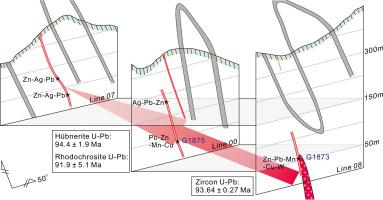桂东梧桐矿床晚白垩世W-Cu-Zn-Pb-Ag矿化与隐伏二长花岗岩
IF 3.6
2区 地球科学
Q1 GEOLOGY
引用次数: 0
摘要
华南远端母金属矿床、近端钨锡铜矿床和隐伏长英质侵入岩之间的时间和成因关系尚不明确,这些不同的成矿类型是起源于统一的岩浆-热液系统还是离散的事件仍存在不确定性。广西东部梧桐含钨铅锌银矿床是一个与隐伏斑岩二长花岗岩成因相关的岩浆-热液体系,以生产宝石级红锰矿而闻名。对h本文章由计算机程序翻译,如有差异,请以英文原文为准。

Late Cretaceous W-Cu-Zn-Pb-Ag mineralization and concealed monzogranite in the Wutong deposit, eastern Guangxi, South China
The temporal and genetic relationships among distal base metal deposits, proximal W-Sn-Cu deposits, and concealed felsic intrusion in South China remain ambiguous, with persistent uncertainties regarding whether these diverse mineralization types originated from unified magmatic-hydrothermal system or discrete events. The Wutong tungsten-bearing Pb-Zn-Ag deposit in eastern Guangxi, South China, is renowned for producing gem-quality rhodochrosite and serves as a magmatic-hydrothermal system genetically associated with concealed porphyritic monzogranite. Detailed ore microscopy, μ-XRF-EDS analysis on polished thin sections and slabs, backscattered electron (BSE) and cathodoluminescence (CL) of hübnerite unequivocally reveal a three-stage paragenetic sequence: (i) disseminated scheelite within altered sandstone and tabular hübnerite-pyrite-quartz veins; (ii) needle-like hübnerite intergrown with sphalerite-pyrite-chalcopyrite-galena assemblages accompanied by pink rhodochrosite, purple fluorite, and quartz; and (iii) silver-enriched base metal carbonate veins containing strong pink or red-rich rhodochrosite crosscutting the former veins. LA-ICP-MS zircon U-Pb dating first defines the age of the Wutong concealed monzogranite at 93.64 ± 0.27 Ma (2σ, MSWD = 0.67). Zircon εHf(t) values (−8.1 to −11.5) correspond to Paleoproterozoic crustal model ages (TDMC = 1886–1676 Ma), indicating that the Wutong monzogranite derived from the partial melting of Paleoproterozoic crust. LA-ICP-MS hübnerite U-Pb dating (95.5 ± 1.9 Ma, 2σ, MSWD = 3.1) and complementary LA-SF-ICP-MS rhodochrosite U-Pb analysis (91.9 ± 5.1 Ma, MSWD = 0.8) delineate W-Mn polymetallic mineralization within a narrow Late Cretaceous timeframe (<3 Myr duration), irrefutably establishing genetic links between magmatism and mineralization. The identification of Late Cretaceous felsic intrusion and associated W-Cu-Zn-Pb-Ag mineralization in eastern Dayaoshan district further highlights the region’s exploration potential for analogous mineralization. Integrating our new high-precise geochronological data with previous studies conclusively aligns the Nanling’s Late Cretaceous W–Sn-base metal mineralization with coeval Eurasian continental margin metallogenic belts. The Wutong deposit enhances the understanding of Late Cretaceous mineralization in South China which providing insights for identifying analogous deposits in comparable magmatic-metallogenic settings.
求助全文
通过发布文献求助,成功后即可免费获取论文全文。
去求助
来源期刊

Ore Geology Reviews
地学-地质学
CiteScore
6.50
自引率
27.30%
发文量
546
审稿时长
22.9 weeks
期刊介绍:
Ore Geology Reviews aims to familiarize all earth scientists with recent advances in a number of interconnected disciplines related to the study of, and search for, ore deposits. The reviews range from brief to longer contributions, but the journal preferentially publishes manuscripts that fill the niche between the commonly shorter journal articles and the comprehensive book coverages, and thus has a special appeal to many authors and readers.
 求助内容:
求助内容: 应助结果提醒方式:
应助结果提醒方式:


